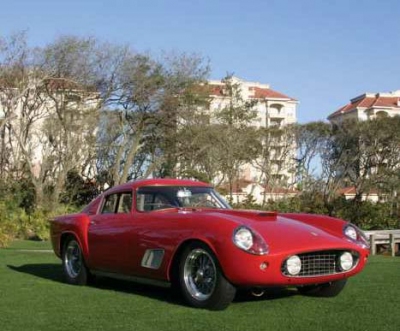SCM Analysis
Detailing
| Vehicle: | 1959 Ferrari 250 GT TdF Competition |
| Number Produced: | 77 |
| Original List Price: | $11,000 |
| Tune Up Cost: | $2,000 |
| Distributor Caps: | $400, two required |
| Chassis Number Location: | Front frame tube |
| Engine Number Location: | Rear engine mount |
| Club Info: | Ferrari Club of America, Box 720597, Atlanta, GA 30358 |
| Website: | http://www.ferrariclubofamerica.org |
| Alternatives: | 1960 Aston DB4GT Zagato; 1950 Jaguar XK C-type; 1955 alloy 300SL Gullwing |
| Investment Grade: | A |
This car sold for $1,475,000 at RM’s Monterey auction in August 2005.
The catalog description overstates the case when it refers to this car as a “Competition” Berlinetta. All TdFs, with their lightweight aluminum bodies and spartan interiors, could be called competition cars, and many were raced.
But cars ordered by dedicated competitors had engine modifications and body variations, one of which was sliding plexiglas side windows to save weight over the normal wind-up windows. Cars destined for long-range events also had outside gas fillers. This car has normal wind-up windows, but does have an outside filler. It was originally painted green and delivered to Luigi Chinetti in New York.
As far as modifications, only the original factory build sheets will tell the tale of whether it came with “competition” features such as a higher compression ratio, special exhaust, different rear-end ratio, and larger gas tank.
Whether or not it was built as a competition car, one aspect of a car’s value is how often and how successfully it was raced. Here’s what’s known about S/N 1161’s competition history. First, the car was directly imported to the U.S., so it never ran in any major international events. Period photos show it with full bumpers, and Jesse Pourret says in his exhaustive book, The Ferrari Competition: The 250 Gran Turisimo Berlinetta, that it was, “A normal looking 1958 Berlinetta.” Chinetti most likely sold it to Bob Grossman’s dealership. Grossman was a talented and dedicated racer, competing at Le Mans many times.
David Sielstad, long-term Ferrari owner and historian, says the following has been verified. On August 28, 1960, at a club race at Bridgehampton, Bob Grossman raced a dark green TdF for the MG car club team and won. Since S/N 1161 was originally dark green-an unusual color-the assumption is that this is the car Grossman drove. This is the only time Grossman definitely raced S/N 1161 that can be verified.
However, as RM stated in its catalog, S/N 1161 may have been owned by wealthy Ferrari fan Walter Luftman, who was a good friend of Grossman. Records show that Luftman probably raced S/N 1161 three times in 1959, at Montgomery, Bridgehampton, and finally Lime Rock, where he won.
Grossman told Sielstad that Luftman would stop by his dealership about once a week and every time he visited, Grossman sold him a car. Grossman told Sielstad that Luftman’s wife hated racing, so Walter would tell her he was going fishing. His cover was blown when he won at Lime Rock and it made the papers. Later, he rolled a GTO and that got in the papers too, ending his racing career.
The next known owner of S/N 1161 was Pete Sherman in Maitland, Florida, in 1962; Sherman was a “curbstoner”-a dealer who operates without premises or license. He kept the car for seven years, advertising it as late as October 1969 for $4,500.
Sherman had a love of fast cars and planes, and an obscure past. We at FAF Motorcars, the Atlanta dealership, dealt with him on a number of occasions, and after visiting our unglamorous dealership behind a cement factory, he gave us his approval because we kept our overhead low, something he claimed to have learned from the CIA.
Sherman was killed in the mid-’70s when he crashed his beloved P51 Mustang. Prior to that he had sold S/N 1161 to another famous “curbstoner,” John Delamater, in Indiana, who helped Ken Hutchinson to build his collection.
When Hutchison got it, S/N 1161 was pretty rough. It ran, but each time it hit a bump more green paint flaked off. Hutchinson owned this TdF until 1986, when it was sold to a Japanese collector and restoration began in 1987. The restoration was done by SCM’s Mike Sheehan, who said the car must have been stored in a very wet area. Everywhere that steel and aluminum came together was nothing but white powder. The corrosion was massive and Sheehan had to replace the entire bottom of the car, finally finishing in 1991. Its color was changed from dark green to red. In 1995, with its Pebble Beach restoration, the car was advertised for $625,000.
So what we have here is an excellent car, after a thorough restoration. It has minor U.S. competition history, and some colorful early owners. The restoration has held up well but shows wear from vintage racing outings.
So does all this add up to $1.5 million? This is a record price for a “regular” TdF without significant international competition history, according to SCM records. But it is indicative of where the TdF market is today. With only 77 built, buyers are paying a premium for cars that still have their original engines, and that haven’t been rolled up into a ball or burned to the ground in a fire at some point in their lives.
So, as is so often the case these days with blue-chip vintage Ferraris, we would have to say that while this was a record price, the car was worth it, and we’ll surely see this price exceeded in the next few months.
